| Film Title/Year and Description of Disaster Film Scene | |
Night and Ice (1912, Ger.) (or Night Time in Ice) (aka In Nacht und Eis) One of the earliest disaster films, this rare and restored film was the first of many feature films about the doomed ship that sank in 1912 on its maiden voyage, after striking an iceberg. This film was made in studios in Berlin, and on an actual shipboard (the German liner Kaiser Auguste Victoria) and released a few months after the RMS Titanic's actual sinking! It was of epic length (35 minutes) in comparison to other films of the time. The filmmakers sunk a real boat to show realism. | 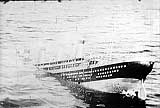 |
Saved From the Titanic (1912) This 1-reel, 10 minute film from the Eclair Film Co. depicted the sinking of the Titanic, told in flashback by the film's star and screenwriter Dorothy Gibson, who was an actual survivor of the tragedy. It took less than a week to film. The Titanic sinking has become the most used disaster film subject, with dozens of retellings. | 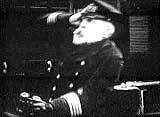 |
Atlantis (1913) One of the first full-length films ever made, with a 1 hour, 53 minute running time; this version of the Titanic story, made only a year after the disaster, was from Denmark (but filmed off the coast of New Zealand) and made by director August Blom; it told about a doctor's voyage on an oceanliner that hit an obstruction and began to sink. It was a very realistic and naturalistic-looking Titanic film with a well-staged action scene of the ship's sinking. It was also one of the most popular films of the 1910s, and a worldwide smash hit. |  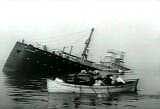 |
Beloved Adventurer (1914) This early silent film (a 15-episode serial of one-reel melodramas), from the Lubin Film Manufacturing Co., portrayed a small-scale disaster: the head-on collision of two locomotive trains facing each other on the same track. | 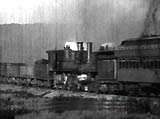 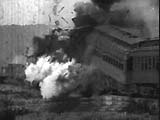 |
Male and Female (1919) In this Cecil B. De Mille film - star actress Gloria Swanson (as spoiled and rich Lady Mary Lasenby) was put into peril when the yacht she was traveling on was shipwrecked on rocks of a deserted island. The interior of the boat filled with water as she was trapped below and struggled amidst the floating pieces of furniture, although she was eventually able to emerge from a hole in the yacht's side and escape. | 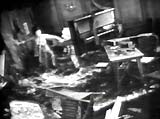 |
This film climaxed with the spectacular flooding scenes of the underground city, with its tracking camera, when the children are led to safety from the rising waters. | 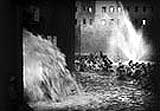 |
Noah's Ark (1928/29) Originally a silent film - and then made into an early 'talkie' a year later (with several stultifying scenes of Vitaphone sound-on-disk dialogue) -- about the Biblical story of the 'Great Flood', directed by Michael Curtiz. This early epic 'talkie" was intercut with a parallel melodramatic romance story about soldiers in the Great War - with moralizing about the hedonistic sins of the Jazz Age and Wall Street speculation. The parallel intercutting was reminiscent of D.W. Griffith's | 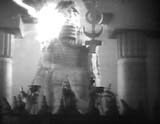 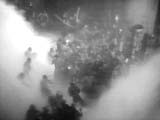 |
The final sequence of the film involved a terrifically destructive tornado/cyclone -- and one of the most suicidal and terrifying stunts and scenes in screen history. Steamboat Bill, Jr. (Buster Keaton), groggy and dizzy, stood up in front of the house that was about to be ripped apart from the forceful winds. As he paused there, the entire two-ton facade or front of the building fell forward and crashed down on top of him. All that saved him was a small window opening in the upper story, through which his body passed. He ran from the collapsed building on the ground and just avoided being flattened by another disintegrating house. When he turned to run away, he was propelled down the street - sliding, tumbling, and turning like other wind-blown objects. He struggled to run into the wind, bending forward at a significant angle but without making any progress. | 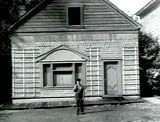 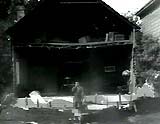 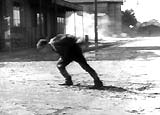 |
The Wind (1928) Victor Sjöström directed this silent film about the relocation of Letty (Lillian Gish) from Virginia to the windblown frontier ranch/farm of her male cousin, where she experienced jealousy, an unending desert prairie sandstorm, and ultimately madness in the face of misdirected passion and the relentless tempest. In the film's finale, she shot male assailant Wirt Roddy (Montagu Love), buried him in the shifting sands, and watched in horror as his corpse was uncovered. The film was made in California's inhospitable Mojave Desert under temperatures of up to 120 degrees, with sand projected by multiple airplane engine propellers. |   |
Atlantic (1929, UK) This mostly fictionalized, overacted, melodramatic tale was based on Ernest Raymond's play The Berg. It was another film inspired by the Titanic sinking - although the ship's name was Atlantic, not Titanic. It was the first sound film about the doomed ship - a compilation of the best footage from both the German-language talkie version and the English-language version. |  |
Deluge (1933) The first big-budget "talkie" disaster film with impressive visual effects about tidal waves devastating various California coastal cities and New York City. | 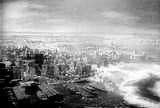 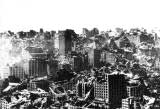 |
The first "gigantic monster rampage" film, a classic adventure film about Beauty and the monstrous ape Beast. The colossal hairy creature, once returned to Manhattan Island, went on a rampage (attacking the elevated subway) and created havoc, before falling to his death from the 'Empire State Building' (the World Trade Center in a later version). Remade in the 'disaster film' decade of the 70s as a modernized King Kong (1976) by producer Dino De Laurentiis, starring Jeff Bridges and Jessica Lange - and then an awful followup called King Kong Lives (1986) that added a Lady Kong, and another remake by The Lord of the Rings director Peter Jackson, as King Kong (2005), starring Adrien Brody, Jack Black and Naomi Watts - with a computer-generated ape. | 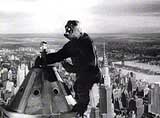 |
The Last Days of Pompeii (1935) Merian C. Cooper's and Ernest Schoedsack provided special-effects for this version of the Mt. Vesuvius eruption in 79 A.D - a holocaust of flowing lava over the Roman city of Pompeii. It was made earlier as an Italian silent in 1913 and in 1926 - and also later remade in 1959 (with Steve Reeves) and 1984 (as a TV mini-series). | 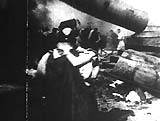 1926 |
San Francisco (1936) This Best Picture-nominated film recreated the famous April 18th, 1906 earthquake in the City by the Bay at its conclusion (with the earth splitting apart and a subsequent devastating fire). The film was a big moneymaker for MGM, and out of its five Academy Awards nominations, it won for Best Sound. |  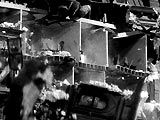 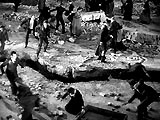 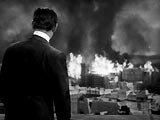 |
Things to Come (1936, UK) British producer Alexander Korda's cautionary and epic view of the future was directed by visual imagist William Cameron Menzies and starred Raymond Massey (as pacifist intellectual and messianic scientist John Cabal). The imaginative, speculative and preachy English film was based on an adaptation of H.G. Wells' 1933 The Shape of Things to Come and was set during the years from 1940 to 2036 in 'Everytown' (London) - spanning a time of international warfare to a future time of television, jet planes, dictators, and a rocket to the Moon (a Giant Space Gun). The visionary anti-war film included a lengthy global world war (presaging WW II!), a despotic boss-tyrant named Rudolph (Ralph Richardson) in a "dark ages" 1970s, a prophetic Brave New World-view, the dawn of the space age, and the attempt of social-engineering scientists to defeat the warlords, save the war-ravaged world with superior technology, and make a new start for mankind. | 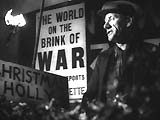 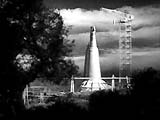 |
The Good Earth (1937) This Best Picture-nominated film featured a buzzing, marauding locust attack on the land recreated with special effects, accompanied by the frantic efforts of poverty-stricken farmers to save their lands. With five Academy Award nominations, including two wins for Best Actress and Best Cinematography. | 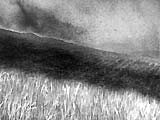 |
History is Made at Night (1937) A suspense thriller that featured a ship-and-iceberg subplot. It also told about an insanely jealous shipping magnate (Colin Clive) who ordered his ship's captain to pilot his ship, The Princess Irene, into treacherous Northern waters in an attempt to kill his ex-lover and her suitor (Jean Arthur and Charles Boyer). | 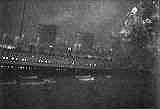 |
The Hurricane (1937) Samuel Goldwyn's film was considered the classic movie spectacle - with a monstrous, South Pacific tropical storm, massive tidal waves and battering gale-force winds - and major stars Dorothy Lamour and Raymond Massey. Remade in 1979 with Mia Farrow and Jason Robards. With three Academy Award nominations, including Best Score, Best Sound, and Best Supporting Actor (Thomas Mitchell). |  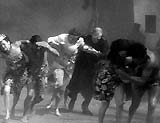 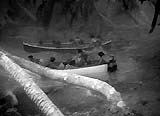 |
In Old Chicago (1938) A Best Picture Oscar nominee, with a spectacular 20-minute fire sequence in the film's climax (a dangerous sequence filmed on the studio's back lot with 1500 extras and a herd of cattle) - the burning down of Chicago by a great inferno in 1871 - caused by Mrs. O'Leary's (Best Supporting Actress Oscar-winner Alice Brady) cow kicking over a lantern. This film was 20th Century Fox's answer to MGM's hit San Francisco (1936). With a total of five nominations and only one win. | 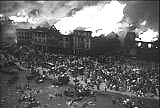 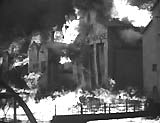 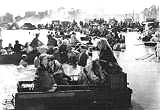 |
Suez (1938) A spy thriller starring Tyrone Power, noted for its sandstorm sequence. Nominated for three Academy Awards: Best Score, Best Sound, and Best Cinematography. | 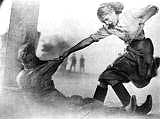 |
With the celebrated scene of wounded Confederate soldiers at the make-shift train station hospital, and the burning of Atlanta (actually the burning of the set for King Kong (1933)). Nominated for thirteen Academy Awards, with eight wins for Best Picture, Best Actress (Vivien Leigh), Best Director (Victor Fleming), Best Film Editing, Best Cinematography, Best Art Direction, Best Screenplay, and Best Supporting Actress (Hattie McDaniel). Its Best Visual Effects nomination was defeated by The Rains Came (1939), see below. | 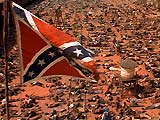 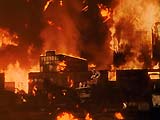 |
The Rains Came (1939) This was Darryl F. Zanuck's and 20th Century Fox's epic production - the biggest disaster epic of the decade. With a spectacularly-staged major earthquake and epic catastrophic flood sequence (after a dam burst with a combination of miniatures and live-action footage) in the Indian city of Ranchipur were followed by a cholera plague. This film won the first-ever Visual Effects Academy Award, beating Gone With the Wind (1939) and five other films. A remake was made called The Rains of Ranchipur (1955). | 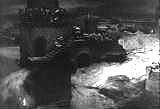 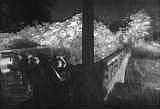 |
Notable for the cyclone sequence that carried the farmhouse along with Dorothy (Judy Garland) and her dog Toto to the colorful world of Oz. Nominated for five Academy Awards, and winning two: Best Song and Best Score. Its Visual Effects nomination was defeated by The Rains Came (1939) - see above. |  |
Typhoon (1940) This was Paramount Studio's response to the popular film The Hurricane (1937) - see above, that also starred sarong-wearing Dorothy Lamour as its leading lady. The film was set on an island near Dutch Guinea, and featured a climactic typhoon and tidal wave in its final minutes - preceded by an island vegetational fire. Nominated for only one Academy Award: Best Visual Effects, which it lost to The Thief of Baghdad (1940). | |
Lifeboat (1944) Alfred Hitchcock's suspense/thriller featured the survival efforts of nine passengers (including Tallulah Bankhead) of a torpedoed liner in a wrecked lifeboat. The film included the destruction of three ships -- the American oceanliner by a German U-boat (which itself was destroyed), and a Nazi German ship. Nominated for three Academy Awards, Best Director, Best Cinematography, and Best Original Screenplay (John Steinbeck). |  |
No Highway in the Sky (1951) In this dramatic thriller based on Nevil Shute's novel, James Stewart starred as aeronautical engineer Theodore Honey who forecast that the plane he was flying in would crash - because of metal fatigue after 1440 hours, although the plane's captain was skeptical. The film dramatized how advancing technological and scientific knowledge could be used to predict disasters. | 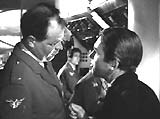 |
When Worlds Collide (1951) Based on the 1933 sci-fi novel by Philip Gordon Wylie and Edwin Balmer. Producer George Pal's Technicolored apocalyptic film, an influential film for future filmmakers, featured end-of-the-world major disasters, such as worldwide fires and flooding (waves crashed into NYC), with a small segment of humanity escaping a doomed Earth in a Noah's Ark-styled rocketship (with about 40 participants selected by lottery, plus animals and livestock) built by a billionaire, to recolonize on the paradisical planet Zyra (seen in the last matte-painted image). The film's scientist had predicted an apocalypse - that the planet Zyra would pass close to the earth in about 8 months and cause massive tidal waves, earthquakes, fires, avalanches, the collapse of buildings and bridges, etc. 19 days after this catastrophe, the planet's star named Bellus would collide with whatever remained of the world. It was nominated for two Oscars (including Best Cinematography) and won the Academy Award for Best Visual Effects. [To be remade by Stephen Sommers in 2010.] | 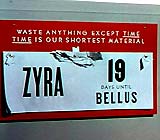 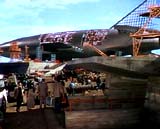 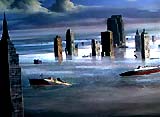 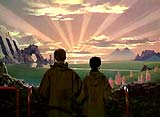 |
The Greatest Show on Earth (1952) Cecil B. De Mille's Best Picture winner featured a disastrous circus train wreck - one of the best aspects of this film. With five Oscar nominations and two wins, including Best Story. | 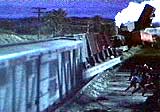 |
Titanic (1953) This 20th Century Fox film featured an Oscar-winning screenplay by Charles Brackett, Walter Reisch, and Richard L. Breen, and starred Barbara Stanwyck and Clifton Webb. It was one of the best renditions of the Titanic films and a model disaster film about the sinking of the ocean liner in 1912. The 20th Century Fox production featured a star-studded cast headed by Clifton Webb and Barbara Stanwyck, and was most memorable for a recreated shot from the lifeboats watching as the ship (a 20 foot model boat) sank. [An interesting footnote - Gentlemen Prefer Blondes (1953) was simultaneously being filmed on the same ship!] With two Oscar nominations: Best Story and Screenplay (win) and Best Art Direction. | 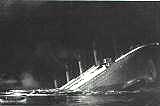 |
The War of the Worlds (1953) The classic and influential film adaptation of the H.G. Wells 1898 sci-fi classic (publicized by Orson Welles' infamous narrated radio play of 1938 that scared the world), the definitive Martian alien-invasion film (copied repeatedly afterwards, especially by the plot of Independence Day (1996)), made by producer George Pal, director Byron Haskin, and Paramount Studios. The film was set in 1950s Southern California (Linda Rosa, about 30 miles from L.A., and then within the city itself), and told of the invasion of hostile Martian spacecrafts shaped like green manta rays with cobra probes. The film starred Gene Barry as a heroic scientist and Ann Robinson as his obligatory love interest, amidst the devastation. The aliens invaded in manta ray-like space ships with cobra-like probes and zapped objects with green disintegration rays to destroy 1950s Los Angeles, forestalled only by their demise from minute bacterial agents. Winner of the Academy Award for Best Visual Effects for its spectacular state-of-the-art visual fx, with two other nominations (Best Film Editing and Best Sound). Remade by Steven Spielberg as the spectacular War of the Worlds (2005), an updated version with disaster film elements, about sinister attacking aliens from the perspective of divorced father Ray Ferrier (Tom Cruise) with two children in the New York area -- with haunting recollections of the 9/11 nightmare. | 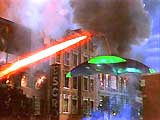 |
Godzilla (1954, Jp.) (aka Gojira) and the Japanese Monster Movies Japan's Toho Studios (and director Inoshiro Honda, known as "The Father of Godzilla") contributed to the "creature feature" output after noticing the influence of Ray Harryhausen's The Beast From 20,000 Fathoms (1953) with stop-motion animation. Unlike that movie, this and subsequent Japanese monster movies would feature actors in giant, rubber monster costumes, fake-looking miniatures, and double-exposure photography. The film would be released in the USA as Godzilla, King of the Monsters (1956) with 40 minutes excised from the film and 20 minutes of new footage, including Raymond Burr as an American reporter. The film launched a slew of Japanese monster movies with such giant atomic creatures as Gamera (a flying turtle), Rodan (a pterodactyl), Mothra (a moth), Ghidorah (a 3-headed dragon), Dagora (flying jellyfish) as well as Godzilla clones named Agon and Gappa. Two remakes of the original, Godzilla 1985 (1985) and Roland Emmerich's big budget Godzilla (1998) would flop miserably in the box office. | 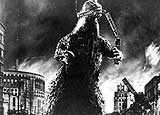 |
The High and the Mighty (1954) This drawn-out, Cinemascopic William Wellman adventure/disaster film and melodramatic character study, adapted from pilot-turned-novelist Ernest K. Gann's novel, starred co-producer John Wayne as a veteran commercial airline co-pilot (with a haunted past) next to Captain Robert Stack aboard a San Francisco-bound flight from Honolulu. When the plane lost an engine and ran low on fuel at the point of no return, the passengers in the ensemble cast contemplated their lives and mortality. Like Zero Hour! (1957), it was one of the earliest airplane-disaster films and served as the blueprint for 70's airplane-related disaster films, such as Airport (1970). Nominated for six Oscars (including Best Director and two Best Supporting Actress nods for Claire Trevor and Jan Sterling), with one win for Best Score. |  |
The Giant Mutated Monster and Giant People Films of Bert I. Gordon (1957-1977) The famed schlockmeister B-director Bert Gordon (nicknamed Mr. Big, whose initials were B.I.G.) specialized in cheesy "giant mutated monster and giant people" films (often with disaster film elements) with cheap special effects, the most famous being The Amazing Colossal Man (1957), about Army Lt. Colonel Glenn Manning (Glenn Logan), who in a futile attempt to save a downed pilot, was blasted by a plutonium bomb, and grew to the height of 50 feet as a bald giant and then rampaged through Las Vegas, where he fell off Hoover/Boulder Dam to his apparent death. (It was followed by an inferior sequel War of the Colossal Beast (1958), notable only as a B/W film with a color finale when the Beast was electrocuted.) Other notable Gordon films included the giant grasshopper film Beginning of the End (1957) (that resembled Them! (1954)) starring Peter Graves, Earth Vs. the Spider (1958) (remade as a 2001 TV movie), a beach-party rock 'n' roll monster filmVillage of the Giants (1965) starring young Beau Bridges, Ron (as Ronny) Howard, Tommy Kirk and Johnny Crawford, The Food of the Gods (1976), and Empire of the Ants (1977) about giant marauding mutated ants in backwater Florida; most of Gordon's films were lampooned by Mystery Science Theater 3000. | 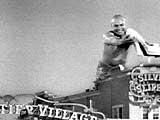 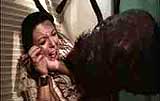 |
The Rains of Ranchipur (1955) A semi-remake of The Rains Came (1939), itself nominated for only one Oscar for Best Visual Effects. Filmed in Pakistan. With Richard Burton, Lana Turner, and Fred MacMurray. | 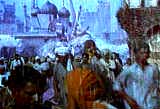 |
With many special effects of natural disasters (especially during the plagues): the parting of the Red Sea, the Burning Bush, etc. With seven Academy Award nominations, with one win for Best Visual Effects. | 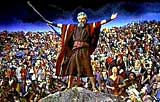 |
Zero Hour! (1957) This relatively obscure disaster film would become famous as one of the first of the in-flight disaster films that would soon follow in the decade of the 70s. The author of this film's derivative teleplay, Arthur Hailey, would later write the novel and screenplay for Airport (1970). This film was also the basis for the classic gagfest spoof Airplane! (1980), and provided many of the cliches for future films. In this routine, melodramatic air disaster film, the two pilots of a commercial Canadian passenger plane became incapacitated, with half of the crew, due to contaminated food (tainted fish). Shell-shocked ex-RAF pilot in WWII, Ted Stryker (Dana Andrews), was the only passenger with previous flight experience, who happened to be on board when he followed estranged wife Ellen (Linda Darnell) and son Joey (Raymond Ferrell) onto the plane as they were departing to start a new life in Vancouver. | 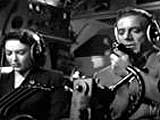 |
A Night to Remember (1958, UK) Before James Cameron's Titanic (1997), this was considered the biggest and best of the Titanic films in terms of acting, writing, visual effects and stuntwork. An almost semi-documentary work, it was adapted by Eric Ambler from the best-selling book by Walter Lord, and told the story of the vessel's launch and then sinking on the fateful night of April 14, 1912. The climactic sequence of striking the iceberg and the sinking was re-created with careful accuracy and filmed close to "real time." |  |
On the Beach (1959) Stanley Kramer's bleak black and white melodramatic film, based on Nevil Shute's novel, proposed nuclear annihilation in a post-apocalyptic world (the aftermath of World War III) - this talky Cold War-era doomsday film dramatized the realities of that post-nuclear world, with survivors waiting for their radioactive doom within five months in Australia, the last refuge on Earth in 1964. The crew of a US nuclear submarine took a reconnaissance mission to San Diego, CA in search of the source of a radio signal - despairingly finding that a Coke bottle was caught in a window shade being blown by the wind against a radio transmitter key. With major stars Gregory Peck, Ava Gardner, Anthony Perkins and Fred Astaire (in a rare dramatic role). | 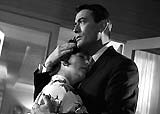 |
The Last Voyage (1960) An action/adventure starring Robert Stack as a man who desperately attempted to find his wife (Dorothy Malone) and children who were trapped in a sinking luxury liner. The film advertised "91 Minutes of the Most Intense Suspense in Motion Picture History!" The initial explosion, the flooding and destruction of the ship, and its dramatic sinking were effectively presented. With only one Academy Award nomination for Best Visual Effects that it lost to The Time Machine (1960). | 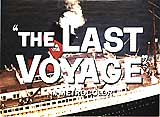 |
The Day the Earth Caught Fire (1961, UK) This apocalyptic film told about the Earth's orbit shifting when both the USA and the USSR exploded nuclear bombs at the same time, causing the Earth to slowly drift into the Sun. |  |
Panic In Year Zero (1962) A film about the degradation of humanity after a nuclear apocalypse, starring Ray Milland. |   |
Alfred Hitchcock's classic, and one of the first "animals attack" disaster films, featuring Oscar-nominated Visual Effects (by Ub Iwerks) for the massive bird attacks on a sleepy northern California seaside town. |   |
Fail-Safe (1964) Another political doomsday disaster film during the Cold War era (a serious and very bleak version of Kubrick's black comedyDr. Strangelove, Or: (1964)), from director Sidney Lumet, about how World War III could actually happen -- in this hypothetical film, misguided transmissions from Strategic Air Command (SAC) headquarters erroneously sent a squadron of US bombers with atomic weapons flying towards Moscow to attack. The tense 'race-against-time' was to try to beat the 'fail-safe' position when pilots would no longer have to follow orders. | 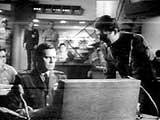 |
The first film in the series depicted a post-apocalyptic, post-nuclear futuristic planet (Earth) - revealed in the film's startling conclusion by a half-submerged Statue of Liberty. All of the films told about apes that had evolved into an intelligent society, with advanced make-up techniques that reversed the social positions of intelligent humans and brutal apes to slyly criticize racial stereotypes. The classic films were derived from Pierre Boule's novel Monkey Planet, and also examined the effects of technology upon humankind. |   |
Krakatoa, East of Java (1969) This disaster film, advertised as "The Incredible Day That SHOOK the Earth to Its Core", was based on the most explosive volcanic eruption in recorded 19th century history - on August 27th, 1883, on the island of Krakatoa. Nominated for one Academy Award: Best Visual Effects. With Maximilian Schell, Diane Baker, and Brian Keith. |  |
Marooned (1969) It was the first astronauts-in-danger film, about astronauts whose rockets refused to ignite to return to Earth. With dwindling oxygen, one of the astronauts named Jim (Richard Crenna) sacrificed his life during a spacewalk so the other two would live. Notable in that it preceded the real-life Apollo 13 incident by a mere 5 months (and the Danish release by only 12 days!). Nominated for three Academy Awards (including Best Cinematograpy and Best Sound), and winning for Best Visual Effects. |   |
Airport (1970) This was the grandfather of them all - adapted from the novel by Arthur Hailey. This Universal film launched the 1970s-80s craze for many other Hollywood airplane disaster films, filmed on a large-scale with an all-star cast. It followed a series of emergency disasters occurring at a large Midwestern hub airport late one snowy night -- at Chicago's Lincoln International Airport (?). Control tower and airport personnel (Burt Lancaster and George Kennedy) negotiated how to land an ill-fated, badly-crippled Boeing 707 (piloted by Dean Martin) that had departed on an evening flight to Rome during a blizzard, and had a bomb explode onboard. Followed by three sequels in 1974, 1977, and 1979. Nominated for an astounding ten Academy Awards (including Best Picture), with one win for Best Supporting Actress (Helen Hayes) as a stowaway. | 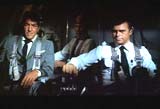  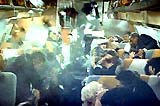 |
The Andromeda Strain (1971) Adapted from Michael Crichton's novel, and directed by Robert Wise - a suspenseful science-fiction disaster-related story about a mysterious organism brought from the returned Scoop 7 space probe/satellite that wiped out an entire village in New Mexico. A team of scientists in the top-secret Project Wildfire lab located in Nevada - a massive, high-tech underground lab facility (set to be detonated if the deadly alien virus was not controlled) raced against time to destroy the microscopic space alien, named the Andromeda Strain, before it threatened to wipe out life on Earth. Nominated for two Academy Awards: Best Art Direction and Best Film Editing. | 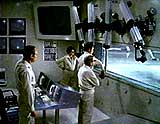 |
The Omega Man (1971) In this sci-fi disaster film set in 1978, Charlton Heston starred as Dr. Robert Neville, apparently the sole survivor of biological germ warfare unleashed on Earth in the mid-1970s during a conflict between China and Russia. After taking the antidote, he struggled to survive in the city of LA over-run by nocturnal, sinister, partially-blind, black-hooded, disease-altered, albinoid mutant scavengers (called "The Family"). They were led by a charismatic, cult-leading zealot named Matthais (Anthony Zerbe), who viewed Neville as personifying the technological evil that destroyed the world. The film ended with various Christ-like allusions, with crucifix-posed Neville sacrificing himself in a pool of blood with a spear in his side. The story originated from the 1954 Richard Matheson novel I Am Legend - which was also the title for the blockbuster remake I Am Legend (2007)starring Will Smith. Richard Matheson also wrote the Italian-made adaptation The Last Man on Earth (1964), with Vincent Price. |  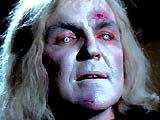 |
The Poseidon Adventure (1972) Noted as the quintessential disaster film by the "Master of Disaster" producer Irwin Allen, combined with a Grand Hotel (1932) cast of characters on New Year's Eve; it included special effects of the ship capsizing due to a giant tidal wave, the overturned dining area, and the creation of the upside-down world inside the ship as ten survivors (cast members Ernest Borgnine, Roddy McDowall, Stella Stevens, Shelley Winters, Jack Albertson, and Gene Hackman) all struggled to live and get to the 'top' (actually the bottom) of the submerged liner. Nominated for eight Academy Awards, with one win for Best Song ("The Morning After"). It also was presented with an Honorary Award for Best Visual Effects. Followed by a lesser sequel in 1979 and a critically-panned remake Poseidon (2006) 34 years later. |      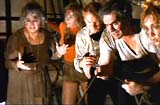 |
Airport '75 (1974) The second of the Airport films - this one about the flight of a Columbia Boeing 747 on a flight bound for L.A. that was rerouted to Salt Lake City and then suffered an in-flight collision with a light private plane piloted by Dana Andrews - and had to be flown by stewardess Karen Black. One of the subplots featured Linda Blair as a heart transplant patient, and other passengers/stars included Myrna Loy, Sid Caesar, George Kennedy and Gloria Swanson (in her last film). |  |
Earthquake (1974) The scenes of the crumbling destruction of Los Angeles by a powerful earthquake were accompanied by the first use of low-frequency bass rumbling Sensurround ("You'll FEEL it as well as see it!") (responsible for the film's only competitive Academy Award Oscar win: Best Sound) and quite impressive special effects. Nominated for four Academy Awards, including Best Art Direction, Best Cinematography, and Best Film Editing. It also won a Special Achievement Award for Visual Effects. The Universal film employed hundreds of stunt extras for the massive crowd scenes, and effectively used front projection, as well as matte drawings to depict the panoramic LA area suffering from a 9.9 level earthquake. It also included 'model' skyscrapers that collapsed, Styrofoam 'concrete,' and a 'miniature' to depict the crumbling Hollywood Dam. The film included cameos and vignettes with many stars, including Charlton Heston, Ava Gardner, George Kennedy, Genevieve Bujold, Debra Scott, Walter Matthau, and more. |   |
Juggernaut (1974) An action 'race-against-time' thriller about seven bombs planted on the Britannic - a luxury cruise liner (captained by Omar Sharif) halfway across the Atlantic with 1,200 passengers - that were due to be detonated by dawn, unless a large sum of money ($1.5 million) was paid by the British government in exchange for defusing instructions to dismantle the complex bombs - Richard Harris starred as the leader of the anti-bomb squad. The film's title was the pseudonym for the blackmailing mad bomber (Freddie Jones) himself. Directed by Beatles' film-maker Richard Lester. |  |
The Towering Inferno (1974) Irwin Allen's most popular and spectacular life-and-death epic disaster film with innovative stunts and a big-name ensemble cast that garnered eight Oscar nominations, including oddly enough, Best Picture and a Best Supporting Actor nod for Fred Astaire. Winner of three Oscars - Best Cinematography, Best Film Editing and Best Song: "We May Never Love Like This Again." With spectacular fire sequences that were filmed in an oversized, blazing skyscraper of 138 stories (with an all-star cast among 300 party guests situated near the top floor while a fire burned below them on the 85th floor) - including the descent of an outside elevator along the face of the burning building, and Steve McQueen as the rescuing firefighter. |  |
The Hindenburg (1975) A docu-dramatization, with lots of sub-plots and melodrama by director Robert Wise, of the explosion of the famous pioneering, but ill-fated lighter-than-air passenger airship-zeppelin. The film followed the ship's last voyage from Frankfurt, Germany to Lakehurst (New Jersey) Naval Air Station, where it crashed and burst into flames while landing in rough weather in May of 1937. The film included the actual newsreel footage of the airship's explosion and fire, with the unforgettable eye-witness 'you-are-there' account of the disaster by news reporter Herbert Morrison. The film won Special Achievement Oscars for its Sound and Visual Effects. With George C. Scott and Anne Bancroft. | 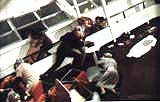 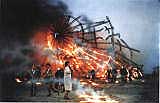 |
The Cassandra Crossing (1976) A West German/Italian co-produced disaster thriller about a virus-infected man (harboring a deadly pneumonic plague) aboard the Transcontinental Express train with 1,000 passengers, from Geneva enroute to Basel, Paris, Brussels, Amsterdam, Copenhagen, and Stockholm. Along the way, the train was quarantined, welded shut, and diverted to Poland via the old and condemned steel Kaslindrliv Bridge, or Cassandra Crossing. With Sophia Loren, Richard Harris, Burt Lancaster, Ava Gardner, Martin Sheen, and O.J. Simpson. |  |
The Food of the Gods (1976) An infamously silly B-movie, and one of the last films by Bert I. Gordon, about an island populated by giant rats, chickens, and wasps. | 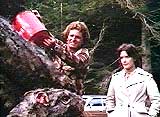 |
Two Minute Warning (1976) A crime thriller-disaster film, with Charlton Heston as the head of the LA Police Department and John Cassavettes as the leader of the SWAT team, at a major-league football stadium (the LA Coliseum) filled with 91,000 fans during a championship game between Los Angeles and Baltimore, and an anonymous psychotic sniper with a high-powered hunting rifle perched on the top of the stadium's scoreboard. This cliffhanger brought suspense to film-goers and mass panic among the spectators as they stampeded in the film's finale. Nominated for Best Film Editing. | 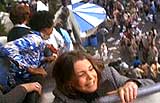 |
Airport '77 (1977) The third Airport film - this one featured the maiden flight of a Boeing 747 on a flight from Washington DC to Palm Beach, Florida being hijacked and crashing into the Bermuda Triangle, then sinking about one hundred feet underwater, and resting on a precarious ledge. With Jack Lemmon, James Stewart, Brenda Vaccaro, Olivia de Havilland, Joseph Cotten, George Kennedy and Lee Grant. Nominated for Best Art Direction and Best Costume Design. |  |
Black Sunday (1977) John Frankenheimer's prophetic film was about a former Vietnam POW who aligned with a terrorist group in a plot to kill thousands of people by loading a bomb on the Goodyear Blimp and exploding it over spectators during Miami's Super Bowl. | |
Rollercoaster (1977) A suspenseful 'disaster' film with an all-star cast (George Segal, Richard Widmark, Henry Fonda, Harry Guardino, and Susan Strasberg) about a crazy terrorizing madman (Timothy Bottoms) who threatened, through extortion, the bombing of additional amusement park rollercoasters in five different locations around the country, if his blackmailing demands for $1 million were not met. It concluded with a tense chase finale at Magic Mountain near Los Angeles. This film was accompanied by the Sensurround effect - to shake the audience in their chairs (it was the third film ever to feature the technological innovation, following Earthquake (1974) and Midway (1976)). |  |
Gray Lady Down (1978) A surprisingly dull Charlton Heston vehicle about an American nuclear sub, the USS Neptune, that, on its way to the naval base port of Groton, CT, crashed into a Norwegian freighter, sank, and found itself trapped on the floor of the ocean about 1,500 feet down. | 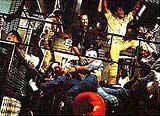 |
A classic superhero film about the 'Man of Steel' that featured Superman (Christopher Reeve) dealing with various catastrophes, such as a falling Daily Planet helicopter (saving reporter Lois Lane (Margot Kidder) in the process) from the roof of the newspaper building, and a lightning-damaged engine on Air Force One carrying the President (saved by Superman flying in its place). In the film's exciting conclusion, there was a cavalcade of disasters following a nuclear explosion of a misdirected rocket missile by evil Lex Luthor (Gene Hackman) in the San Andreas Fault in California, including a buckling Golden Gate Bridge with a school bus dangling off the edge (Superman saved it from falling), a collapsing HOLLYWOOD sign in Los Angeles, a potential train derailment (Superman connected the broken track with his own body), and the bursting of Hoover Dam (Superman saved Daily Planet photographer Jimmy Olsen (Marc McClure) from death). Superman rolled a huge boulder and other rocks into place to save a nearby valley town from a cascade of water. He also resealed the San Andreas Fault by boring underground, pushing plates of land back together, and damming up and redirecting a flow of on-rushing lava. His failure to save Lois from a crevasse that swallowed her car during an aftershock, and suffocated her to death, resulted in him turning back time by circumnavigating the globe at lightspeed, to save her life - ignoring his father Jor-El's (Marlon Brando) cautionary warning about interfering with human history. Nominated for three Academy Awards: Best Sound, Best Film Editing, and Best Score (John Williams). | 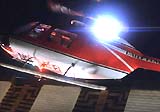 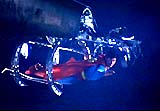  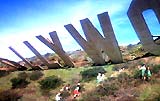   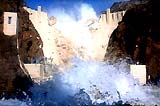 |
The Swarm (1978) A preposterous Irwin Allen film about South American killer bees (originally from Africa) with potent venom that first invaded an American ICBM base, and then a small Texas town and were beginning to infiltrate into major US cities (such as Houston), necessitating containment-suited individuals with flame-throwers to eradicate them. With major stars including Olivia de Havilland, Henry Fonda, Michael Caine, Richard Widmark, Fred MacMurray, Katharine Ross - and others ill-used. In one scene, a helicopter was downed by the insects, and then a passenger train evacuating citizens was attacked by the swarm, derailed and rolled down a hillside. The film contained a curious disclaimer in the end credits: "The African killer bee portrayed in this film bears absolutely no relationship to the industrious, hard-working American honey bee to which we are indebted for pollinating vital crops that feed our nation." |   |
Beyond the Poseidon Adventure (1979) An unnecessary sequel to the classic disaster film, once again about the S.S. Poseidon that was flipped over by a tidal wave, with two rival salvage teams of adventurers (one good led by Michael Caine - the other evil led by Telly Savalas) searching for gold and plutonium simultaneously; with lots of cheaply-shot, unrealistic footage, and inferior character development. |  |
The China Syndrome (1979) An exciting, suspenseful doomsday film about the threat of a nuclear reactor accident, made all the more real by the actual Three Mile Island (Pennsylvania) incident two weeks after the film's premiere. The near melt-down at the power plant in this anti-nuclear power film was averted by the plant manager (Jack Lemmon), but further conspiracies were brought to light regarding shoddy construction, corporate greed, and media manipulation. The film's title referred to a kind of reactor accident that would melt - theoretically - all the way through the earth to China. Nominated for four Academy Awards, including Best Actor (Lemmon), Best Actress (Jane Fonda), Best Art Direction, and Best Original Screenplay. |  |
City on Fire (1979) A badly-conceived Canadian film - and one of the last big-budget, cavalcade-of-stars disaster films of the 1970's, about an oil-refinery explosion (caused by a vengeful pyromaniac) that created a sweeping, chain-reaction series of fires through a small, unnamed Midwestern town. Henry Fonda was again in this as chief of the fire brigade - his fifth disaster film in just a few years - his previous 'disasters' were in Rollercoaster (1977), Tentacles (1977), The Swarm (1978), and Meteor (also 1979). | |
The Concorde: Airport '79 (1979) The last and worst of the Airport series - and almost a precursor to the next year's Airplane! (1980) - this one about a long-running plot to shoot down the Concorde with missiles as it flew to Paris - and causing it to fly upside down and then land without brakes. In another segment of the film, the Concorde continued onto the 1980 Moscow Olympics, when rapid decompression forced it to make an emergency landing in the Alps - where it then burst into flames. George Kennedy (appearing as the co-pilot) was the only well-known actor to appear in all four segments of the Airport series. This film also starred Alain Delon, Susan Blakely, Robert Wagner, Eddie Albert, Mercedes McCambridge (as the coach of the Soviet women's gymnastics team), John Davidson and Sylvia Kristel. |   |
Mad Max (1979, Aust.) A post-apocalyptic, nihilistic trilogy from Australia's George Miller contained both film noir and western genre elements in its sci-fi tale. The films were dark, desolate and grim in nature and set in a scorched-earth Australia with scarce supplies of water and gasoline. The first of the trio was the low-budget, independent original film Mad Max (1979) that introduced Max (Mel Gibson) as a vigilante after the killing of his wife Jessie (Joanne Samuel) and child by a brutal gang of marauding motorcycle punks. The two sequels were: the action-packed, thrilling The Road Warrior (1981) (aka Mad Max 2) with Gibson defending himself and a colony of pioneers beset by roving gangs of Mohawked outlaws, and Mad Max Beyond Thunderdome (1985) set 15 years after the previous installment in a post-nuclear apocalyptic wasteland with Tina Turner as the villainous queen overlord of Bartertown. | 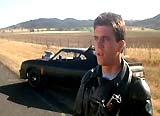 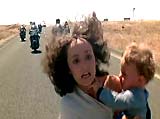 |
Meteor (1979) A big-budget doomsday disaster film from American International Pictures (AIP) and director Ronald Neame (noted for The Poseidon Adventure (1972)), about a massive 5-mile wide meteor (named Orpheus) that was due to strike New York City, thereby causing an earthquake and massive underground and surface flooding. Its tagline was: "It's five miles wide...it's coming at 30,000 mph...and there's no place on Earth to hide!" The film also featured a meteorite fragment destroying the World Trade Center (albeit poorly done), adding a disturbing subtext due to the 9/11 tragedy 22 years later. Launched US warheads eventually reached the meteor in outer space and destroyed it. The film starred Sean Connery and Natalie Wood (with a sliced romantic sub-plot), and Henry Fonda as the President. With one Academy Award nominaton for Best Sound. |  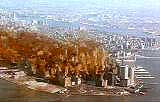 |
Airplane! (1980) This tongue-in-cheek movie was probably the best disaster film spoof ever made, and one of the surprise comedy hits of all-time by The Kentucky Fried Movie trio of writers: David and Jerry Zucker and Jim Abrahams. [In that 1977 film, they lampooned the entire Irwin Allen genre with a hilarious preview trailer for the disaster film That's Armageddon.] This low-brow effort filled with rapid-fire quips, sight gags, and double entendres parodied both Zero Hour! (1957) (from which it took plot and characters) and the various subplots from the Airport films of the previous decade (most notably Airport '75 (1974)'s girl-needing-heart transplant subplot). This film not only launched Leslie Nielsen's comic deadpan career and the Zucker-Abrahams-Zucker films, but destroyed the Irwin Allen-styled, big-budget disaster film genre for many years. High-octane action films with macho male stars and other superheroes would take their place. | 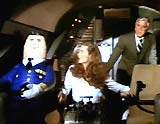  |
When Time Ran Out... (1980) This was notable as producer Irwin Allen's final disaster feature film - the end of the 70s cycle of this sub-genre; it was a routine effort that plagiarized actors and plots from earlier works such as The Towering Inferno (1974) and The Poseidon Adventure (1972); it told of a dormant volcano ready to blow on a tropical island, inhabited by such stars in the locale's luxury resort as William Holden, Jacqueline Bisset, Ernest Borgnine, and others. Paul Newman starred as the hero who saved some of the stars, amidst a volcanic explosion, rumblings, giant fireballs, a tidal wave, and a precarious crossing of a bridge above hot lava. Nominated in Best Costume Design category. |  |
The Day After (1983) One of the better made-for-TV movies, and one of the best-known, most-uncompromising nuclear holocaust films ever made - an ABC-TV program that drew 100 million viewers in the US - the second largest TV audience ever for a dramatic program. About the survivors living in a Midwestern city of a nuclear exchange of missiles between the US and Russia, and the subsequent approaching nuclear winter. | 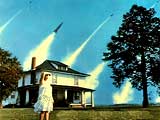 |
Das Boot (1983, Ger.) One of the greatest war films of all-time - this was set on a claustrophobic, disaster-plagued German U-Boat during World War II. Nominated for six Academy Awards, none of which won. | 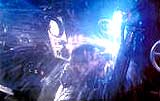 |
The film, the first in a long-running franchise series, opened in the year 2029 in a dark, ruined post-apocalyptic Los Angeles, a scene of devastation where machines ruled the world ("The machines rose from the ashes of the nuclear fire. Their war to exterminate mankind had raged for decades, but the final battle would not be fought in the future. It would be fought here, in our present"). |  |
Runaway Train (1985) A taut action film and a precursor to Speed (1994) -- based on a screenplay by the Japanese director Akira Kurosawa; with Jon Voight and Eric Roberts as escaped inmates from an Alaskan maximum-security prison, who board a runaway train speeding along at high velocity with no brakes (and an engineer who died of a heart attack) - on a collision course down wintry tracks in the Alaskan wilderness. Nominated for three Academy Awards including Best Actor (Voight) and Best Supporting Actor (Roberts). | 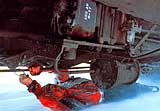 |
Miracle Mile (1988) Steve De Jarnatt's nihilistic noir thriller starred Anthony Edwards and Mare Winningham at the start of World War III. It ended with mass rioting in the streets of Los Angeles when word leaked of an impending nuclear apocalypse. | |
The Abyss (1989) James Cameron's big budget science-fiction spectacle about a nuclear submarine scarily submerged 25,000 feet down, with rescue attempts by an oil-rig crew and Navy SEALS, and featuring the appearance of aquatic aliens, and a famous tidal-wave finale in the restored Director's Cut of the film. This film was nominated for four Academy Awards, and won one for Best Visual Effects. |    |
Alive (1993) A notorious docudrama film about a Uruguayan rugby team whose plane crashed in the Andes in the fall of 1972 in sub-zero temperatures, forcing them to resort to cannibalism to survive after extricating themselves from the twisted wreckage. The film opened with the spectacular airplane crash, and then weeks of struggling survival followed. Based on the novel of the same name by Piers Paul Read. |   |
The Fugitive (1993) A Best Picture-nominated film with an incredible train wreck scene causing Deputy Samuel Gerard (Best Supporting Actor Oscar-winner Tommy Lee Jones) to comment upon the wreckage, "My, my, my, my, my. What a mess." With seven Academy Award nominations (with only one win), including Best Cinematography, Best Film Editing, Best Original Score, Best Sound, and Best Sound Effects Editing. | 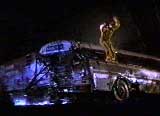 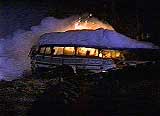 |
Outbreak (1995) A deadly, Ebola-like monkey-borne virus from Africa re-emerged in the US through an illegally-smuggled infected animal, with Dustin Hoffman as the infectious disease expert called to eradicate the deadly airborne virus spreading in a small California town. One digital effects sequence effectively demonstrated how the virus could quickly spread by a sneeze (and its particle-filled viral spray) in a crowded movie theatre. |  |
Daylight (1996) With Sylvester Stallone as the disgraced former head of Emergency Medical Services, who formed a rescue operation when a traffic accident triggered an explosion that sealed both ends of the tunnel under the Hudson River in New York City. Advertised as: "No Air, No Escape, No Time". Death may come through suffocation, by fire, by being crushed, or by drowning. With only one Academy Award nomination: Best Sound Effects Editing. |  |
Independence Day (1996) Director Roland Emmerich's remake, unofficially, of the original alien attack film The War of the Worlds (1953), told of alien invaders overtaking the Earth. Doomsday for the world was signaled by a monstrous, asteroid-sized UFO that entered Earth's atmosphere and hovered over the skyline of NYC. Included a well-publicized images of the White House and Capitol Building being destroyed, and revived the tradition of disaster films of having a large-scale cast. With only two Academy Award nominations, including Best Sound, and the winner of the Best Visual Effects Oscar (defeating Twister (1996)). | 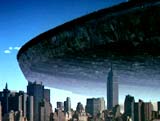 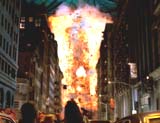 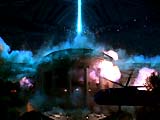 |
Twister (1996) Nature's wrath was unleashed with this Jan de Bont film, when twister-chasing, thrill-seeking meteorologists (Bill Paxton and Helen Hunt) pursued killer tornadoes, with a sensing device nicknamed DOROTHY. State of the art, digital special effects and computer graphics included cows flying through the air. With only two Academy Award nominations: Best Sound and Best Visual Effects. |    |
Dante's Peak (1997) Although formulaic and cliched, it was the better of the two competing volcano disaster films in 1997 (see also Volcano (1997) below). It told about a small Pacific Northwest town called Dante's Peak that was threatened by an erupting volcano. Pierce Brosnan portrayed a volcano expert from the U.S. Geological Survey who warned of the impending disaster - to little effect, until the evidence of massive ash clouds, and rivers of raging mud and molten rock caused death-defying attempts at escape. |   |
Speed 2: Cruise Control (1997) Jan de Bont's race-against-time follow-up to Speed (1994) was about an out-of-control cruise liner aimed at a Caribbean resort town. Willem Dafoe played the copper-poisoned, vengeful wacko villain who hijacked the ship with his laptop computer. The film's most expensive sequence was the liner's slow crash through a pier and a couple of buildings in the resort harbor town. | |
Titanic (1997) James Cameron's masterpiece of historical accuracy chronicled the sinking of the Titanic in the Atlantic on its maiden voyage in 1912. One of the most popular films of all-time, it grossed over a billion dollars worldwide, with complex digital effects, models, live-action and miniatures. Nominated for 14 Academy Awards, and the winner of eleven Oscars, including Best Picture, Best Director, Best Visual Effects, Best Sound, Best Sound Effects Editing, Best Film Editing, and Best Cinematography. | 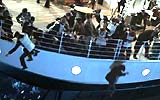 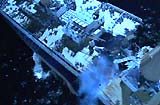 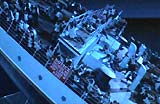 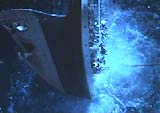 |
Volcano (1997) The title of this disaster film was somewhat of a misnomer -- rather, it was about an underground volcano with a lava vent (LaBrea Tar Pits) that flooded Los Angeles (in the heart of Hollywood) with destructive lava. It showed the efforts of Tommy Lee Jones as a strict emergency management director to barricade the city against the slow-moving menace, with appropriate pyrotechnic special effects - including raining lava. |   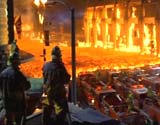 |
Armageddon (1998) One of two competing "killer asteroid" films of 1998 (see also Deep Impact (1998) below) in which a mining team raced to plant explosives on a gigantic meteor. The Michael Bay film featured smaller meteorites devastating New York City. LikeMeteor (1979), it featured now-disturbing imagery of a damaged World Trade Center -- and rogue meteors causing the complete destruction of Paris and Shanghai. With four Academy Award nominations: Best Sound, Best Sound Effects Editing, Best Song, and Best Visual Effects (defeated by What Dreams May Come (1998)). |   |
Deep Impact (1998) A more philosophical, introspective, and character-driven existential film than Armageddon (1998), about a comet splinter that hit Earth - causing a massive, four hundred foot tidal wave that devastated New York City, and the efforts of astronauts (led by Robert Duvall) to prevent further apocalyptic destruction. |   |
A series of hyperkinetic thrillers from the Wachowski Brothers examined the nature of reality in the external world - seemingly uncertain, in which reality was a computer simulation (the Matrix), and the actual Earth was scorched. Evil machines kept humans pacified and fooled by the illusion that mimicked everyday reality. The films were set in the near future (actually about 200 years later, around the year 2199). The character of computer programmer/hacker Thomas Anderson (Keanu Reeves), with screen-name alias Neo was introduced - destined to be a messianic one to save the world. Rebel warrior Morpheus (Laurence Fishburne) explained how life on Earth - the Matrix ("It is the world that has been pulled over your eyes to blind you from the truth") - was only a completely-simulated reality or facade created by malevolent, cyber-artificial-intelligent sentient beings that enslaved humans by imprisoning their minds and bodies ("Like everyone else you were born into bondage. Into a prison that you cannot taste or see or touch. A prison for your mind"). | 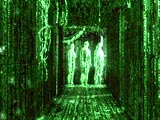  |
Final Destination (2000) A violent plane crash, previsioned by one of the passengers who deplaned, opened this horror film, which was controversially based on the tragic TWA 800 crash. It even used news footage from that crash as stock footage. |   |
The Perfect Storm (2000) A downbeat, nihilistic true story about the Andrea Gail, a North Atlantic fishing troller from Gloucester, Massachusetts that was caught in the fall of 1991 in a violent storm with fifty foot sea swells after two weeks at sea. With George Clooney, Mark Wahlberg, Mary Elizabeth Mastrantonio, and Diane Lane. With only two Academy Award nominations: Best Sound and Best Visual Effects (defeated by Gladiator (2000)). | 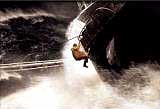 |
28 Days Later (2002, UK) This apocalyptic, sci-fi horror film from director Danny Boyle opened in a completely deserted London, with haunting views of a virus-ravaged landscape, due to the effects of an experimental, laboratory-bred virus or plague. Animal activists had attempted to rescue simian victims from sadistic scientists in the Cambridge Primate Research Center, with disastrous results when the raging, infected animals were set free - the evacuated city became overrun with roaming bands of crazed, diseased zombies as a result of the infectious blood disorder. | 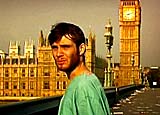 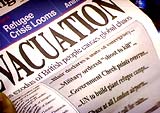 |
This fourth film starring Tom Clancy's hero Jack Ryan (Ben Affleck in the role rather than Harrison Ford) featured a terrorist nuclear bombing of part of the city of Baltimore during a major professional football competition. When the bomb detonated (it was hidden in a cigarette vending machine in the stadium's underground parking area), the shockwaves of the mushroom-shaped nuclear blast destroyed much of the city, and the President's motorcade of cars was toppled. The blast was reported to be from a low-yield device, smaller than the Hiroshima bomb, and it had left a crater a quarter of a square mile around the stadium (ground zero), and other heavily damaged buildings for another quarter mile. The film was delayed in theatrical showings due to the 9/11 disaster, and heavily edited. | 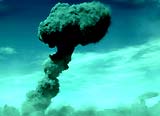 |
The Core (2003) A worldwide ecological disaster film about how the Earth's molten core stopped spinning, causing the unleashing of harmful microwave rays that caused disasters such as earthquakes, bridge collapses, and super electrical-lightning storms all over the world, with a team of scientists on a mission to drill into the core and detonate nuclear warheads -- a preposterous and entirely unscientific idea. |  |
The Day After Tomorrow (2004) An ecological disaster film, the second disaster film from director Roland Emmerich, chronicled the catastrophic climactic after-effects of global warming (the greenhouse effect): with hurricanes, killer tornadoes, earthquakes, floods, tidal waves, and an impending Ice Age. | 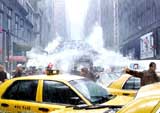 |
George Romero's most recent low-budget "Dead" film, in its "film-within-a-film" framework, began with conflicting and dubious news reports told that there were no clear reason for the chaos in the world, although there was speculation about some kind of germ or epidemic, or natural calamity, or even that everything was a massive hoax. It was obvious that political and social unrest had been unleashed, as a result of the zombie infestation. Student film-makers were interrupted while making a Blair Witch Project-like horror film, and they determinedly took their video cameras and other gadget-techno devices on the road to tell the real truth of the zombie attacks with their own first-person footage. The students believed the government was lying about the causes of the zombie resurrection, and vowed to show the world the truth of what had really happened. The documentary of the unexplainable zombie phenomenon (mostly with long takes and jerky hand-held digital video camera shots) was called The Death of Death. | 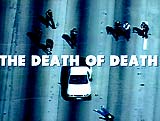 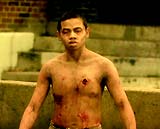 |
I Am Legend (2007) A man-made virus (a genetically-engineered cancer cure that mutated and became deadly) virtually wiped out most of the global population three years earlier. The film's setting was New York City in the year 2012, and the only survivor was ex-military scientist Dr. Robert Neville (Will Smith), a virologist. The previous two versions of the film (adaptations of Richard Matheson's novel) were The Last Man on Earth (1964) with Vincent Price, and The Omega Man (1971) with Charlton Heston. By day, Neville hunted and foraged throughout the starkly deserted and abandoned city (with cars left on the streets), avoiding the zombified, vampirish, virus-infected mutant creatures or hemocytes (called DarkSeekers) that only emerged at night. Major on-location sites in NYC included Times Square, Tribeca, and Washington Square, with one of the most spectacular scenes involving a fragmented Brooklyn Bridge (a $5 million dollar scene). |   |
Knowing (2009) Alex Proyas' sci-fi action disaster thriller was set up with the opening, fifty years later, of a Boston-area elementary school time capsule with letters written by schoolchildren in 1959; the letter of sad, slightly-disturbed schoolgirl Lucinda Embry (Lara Robinson) had seemingly random numbers, deciphered as meaningful code by MIT astrophysics professor John Koestler (Nicolas Cage). He guessed that a series of numbers, such as 911012996, referred to dates of worldwide disasters in the last 50 years, (the World Trade Center disaster on 9/11, the Oklahoma City bombing, natural disasters, plane crashes etc.), and then figured out that the numbers were in sequence by date, body count, and then GPS geographic positional coordinates (latitude and longitude). There were three more deadly events about to happen in the near future, and he experienced all of them - beginning with a realistically-fiery commercial plane crash near Boston's Logan Airport as he was driving on the clogged freeway. He also foretold and witnessed a Worth and Lafayette St. (Manhattan) subway train derailment crash-collision (and his son Caleb (Chandler Canterbury) envisioned a woodland wildfire consuming stampeding deer and moose). The last event was cataclysmic and apocalyptic - a disaster of worldwide proportions due to a massive solar flare (causing energy bursts of radioactivity that destroyed the Earth's ozone layer) that consumed the NYC skyline and Times Square (and eventually the entire Earth), prefaced by chaos in the city's streets. The final number 33 was actually EE="everyone else" written backwards, signifying that there would be no survivors (everyone would die) on October 19, 2009. |  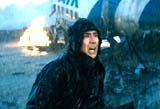 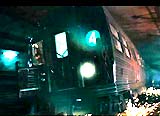 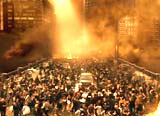 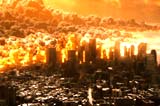 |
2012 (2009) End of days movie-expert Roland Emmerich's latest disaster epic, based upon the Mayan calendar's apocalyptic predictions for the cataclysmic year 2012, followed his own alien invasion Independence Day (1996), Godzilla (1998), the global warming epic The Day After Tomorrow (2004), and the prehistoric 10,000 BC (2008). In this one, the heating up of the Earth's core produced a monstrous earthquake that caused Los Angeles (with buckling freeways and falling skyscrapers) to crack open and fall into the ocean, while Yellowstone National Park succumbed to a volcanic eruption, the Washington Monument toppled, the aircraft carrier USS John F. Kennedy was swept up by a gigantic tidal wave and crashed upside down onto the White House, Rio de Janiero's Christ the Redeemer statue fell, a giant tsunami struck India, the Eiffel Tower was leveled, while a tidal wave inundated the Himalayas, St. Peter's Basilica and the Sistine Chapel crumbled (with Michelangelo's Adam and God painting splitting apart), and an entire cruise ship liner was overturned by a giant wave and sank to the bottom of the ocean. | 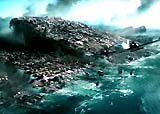 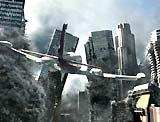  |
0 comments:
Post a Comment